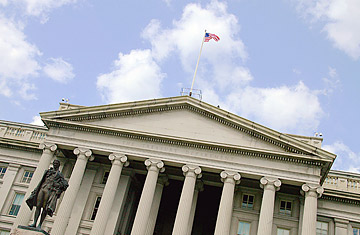
The U.S. Treasury
The longer the credit markets remain dry, the more things are going to die. That's what's behind yet another day of bloodshed on Wall Street, where the market lost 678 points, or 7.33%, in panicky late trading on Thursday. It's also what's behind yet another financial jack-in-the-box move by Henry Paulson at Treasury, who hinted on Wednesday that he was considering using part of the massive $700 billion bailout package approved by Congress to directly buy stakes in banks — after having dismissed the idea less than a week before.
Why the turnaround? It comes down to this: Banks need money. The U.S. government has it. Or can print it. So in addition to the end-around plans to buy mortgage securities and other toxic assets that Paulson and Fed Reserve Chairman Ben Bernanke have been devising, why not go with a more direct approach too?
"A capital shortage is a capital shortage is a capital shortage," says Anil Kashyap, professor of economics and finance at the University of Chicago Graduate School of Business. To Kashyap and a number of economists, this has been the problem from the beginning, and any proposed solution that doesn't address the basic issue of recapitalizing banks won't succeed in the long run. Treasury has now come to the same conclusion: the best way to shore up both the banks' balance sheets and their confidence in lending (to each other, to businesses, to us) is to become an investor in them.
At a press conference on Wednesday, Paulson suggested that he was about to expand his tool kit. "It is the policy of the Federal Government to use all resources at its disposal to make our financial system stronger," he said. "We will use all of the tools we've been given to maximum effectiveness, including strengthening the capitalization of financial institutions of every size." Put another way, a senior Administration official says, the $700 billion is "for everyone; it's for everything: buying assets, insuring assets or purchasing equity, the biggest to smallest."
What would that mean for banks, and how would the program function? First and foremost, the senior Administration official says, it would be voluntary. The banks would come to the government. Treasury would not pick the ones that look like they need help and offer it to them. "We're trying to make these things as systematic and predictable as possible," the official says. "If we moved on this, it would be: Here are the terms; here's how it works; here's the guy to call."
Lending remains absolutely frozen right now, as banks are too frightened to lend to each other — let alone businesses and municipalities, since they're worried about who could go under next. The initial market reaction to Paulson's speech was something on the order of: "Holy [expletive deleted], we must really be in trouble." The market cratered when it heard on Wednesday, losing nearly 190 points on the Dow after trading in the black for most of the day. It tanked again on Thursday.
The big hammer was supposed to be the famous $700 billion bailout bill that Congress signed last week, in which Paulson and Co. were given wide berth to do what they needed to ease the financial panic that all but froze credit markets. Much of the discussion, and the planning, has revolved around how the government would buy up the toxic securities such as CDOs (collateralized debt obligations) that are now poisoning bank balance sheets. The thinking has been that once financial institutions can unload this trash on the government, the gears of commerce will move again. But that takes time to pull off. "It's an inefficient way to inject capital," says Campbell Harvey, professor of international business at Duke's Fuqua School of Business. And it also has risk. "You are potentially injecting capital by buying assets from institutions that don't deserve it."
Directly investing in the banks allows Paulson to get the money to where it is needed the fastest, which would then allow well-capitalized banks to loosen the strings of lending. Nationalization? Not quite. Under such a plan, the U.S. would become a shareholder in banks, taking stock in exchange for the capital injection. The government would essentially become a passive investor. It wouldn't take any board seats, and it wouldn't actively seek to influence how the banks were being run. It doesn't have to; Treasury has regulatory control over the banking system anyway. Harvey has proposed that the government set up an investment vehicle similar to the Resolution Trust Corporation that rode to the rescue following the savings-and-loan crisis in the 1980s.
For now, Treasury is planning to pursue both direct infusions of capital and the purchase of bad assets to help clear the market. But outside observers already have qualms about a voluntary program. The consensus among experts seems to be that Treasury should shoot the wounded and let the surviving banks buy their assets. "There is no use in injecting equity into institutions that are basically insolvent," says Harvey. There's also what's known as the "lemons" issue: any bank that applies for funds might spook investors. The solution is to make all healthy banks participate.
Treasury already has a list of troubled banks, and as the regulator, it knows the banks' financial positions on a daily basis. No doubt these will be among the first volunteers. There is also no doubt that some banks are going to die anyway.
The banking system needs capital. Now. So it makes sense for Treasury to address the problem directly. How much? Good question. Will it work? "It should help," says Kashyap. "The question is, Do they execute in a way that doesn't botch it? They've finally bitten the bullet; now they've got a chance to succeed."
